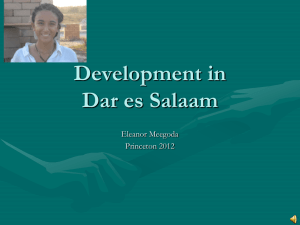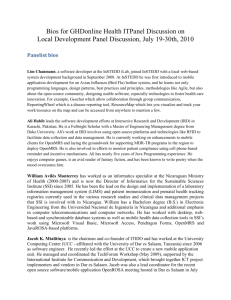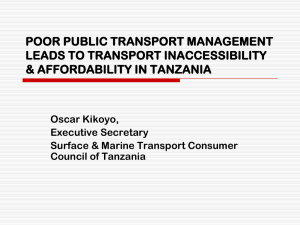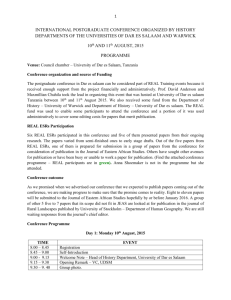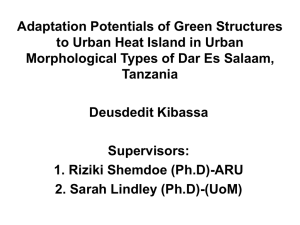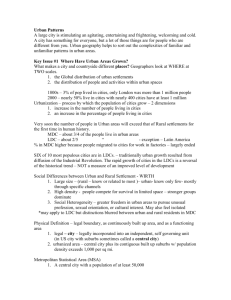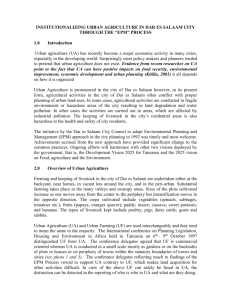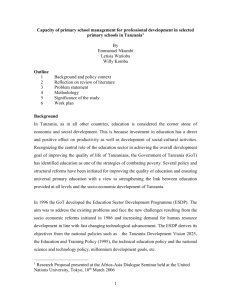Hanna Nassif Community Infrastructure Upgrading
advertisement
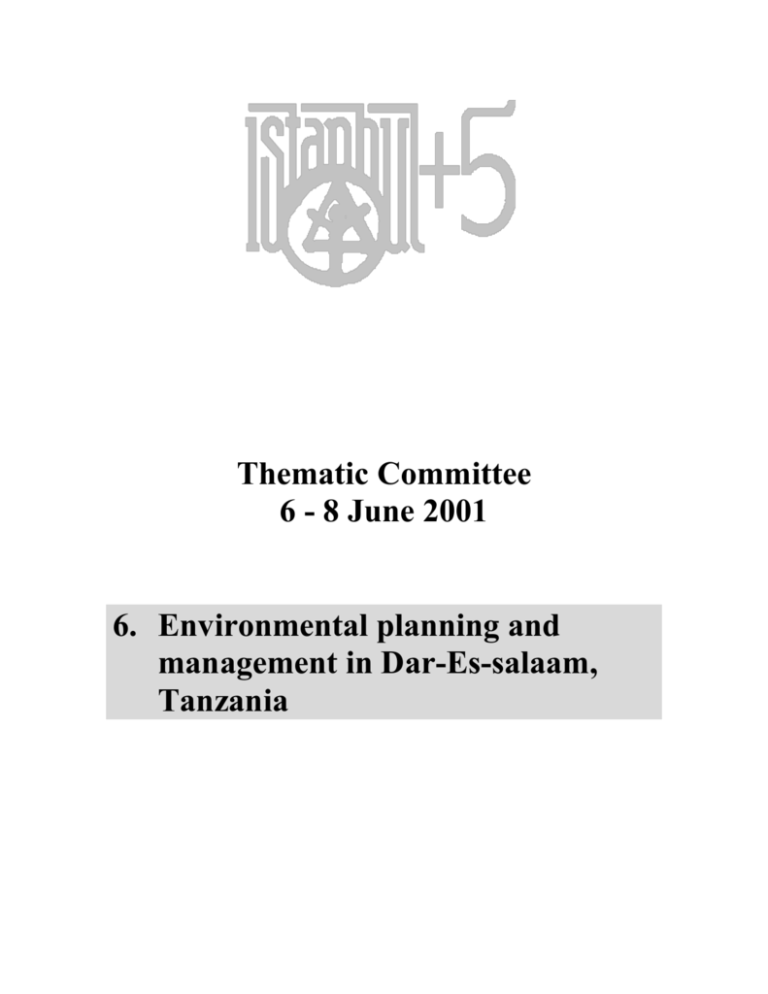
Thematic Committee 6 - 8 June 2001 6. Environmental planning and management in Dar-Es-salaam, Tanzania ENVIRONMENTAL PLANNING AND MANAGEMENT IN DAR-ES-SALAAM, TANZANIA By the Ministry of Lands and Human Settlements Development, United Republic of Tanzania Human Settlements, Shelter and Urban Management Tanzania covers approximately 1 million square kilometres, with the present population of slightly more than 30 million, of which at least 10 million people are urban inhabitants. Current average urban growth rate is 7.0 percent per annum while Gross Domestic Product is US$ 230 per capital. Human settlements in urban areas in Tanzania can be placed in two categories formal and informal. The main characteristic of both types of settlements is lack of basic community infrastructure services including water supply, sewerage, access roads, drainage and solid waste management system. Presently between 40 and 70 per cent of the urban inhabitants live in the informal settlements. More than 95 percent of the houses have been produced by private individuals, mainly through own savings. Even though the majority of urban residents live in the informal settlements, unlike most other Third World Countries, these settlements provide accommodation to people of different socioeconomic status. Overall ,the state of the urban environment up to mid 1990s had deteriorated to the extent that in all Cities and Municipalities the collection of the generated solid and liquid waste was less than 5 percent. Inappropriate urban planning practices and policies (including institutional inefficiencies and lack of coordination among the key actors in urban development) are some of the underlying courses of urban environmental degradation. Since 1996 Tanzania has made significant progress in implementing the Habitat Agenda through the adoption of the Environmental Planning and Management 2 (EPM) approach. This approach is in direct response to paragraph 137 of the Habitat Agenda which calls Governments at all levels to support mechanisms for consultations and partnerships among interested parties to prepare and implement local environmental plans. Unlike the traditional Master Planning, EPM builds partnerships with key stakeholders and provide a forum for setting common priorities. The process of identifying the problems, negotiating strategies and implementing action plans is pursued through a working group approach, with group members drawn from participating institutions. The working groups constitute a formidable basis and operational tools for the successful stakeholders participation as will be outlined in the discussions below. The EPM has been initiated in Dar es Salaam in 1992. Currently the concept is being replicated in all the Municipalities in the country. In total the programme is benefiting at least 50 per cent of present urban population in the country. The two cases outlined below illustrate some of the achievements/impacts realised and lessons learnt during the implementation of the Habitat Agenda. Case 1: Participatory Community Infrastructure Upgrading Hanna Nassif Hanna Nassif is one of the informal settlements that prior to 1996 suffered from lack of basic community services including storm water drains, subsequently, the housing area was experiencing frequent floods. Following a request from the local community, the Government of Tanzania in collaboration with donor agencies and with participation of the residents initiated Hanna Nassif Community Based Upgrading. The project took an innovative approach in both its institutional set-up and the use of labour-based community contracting and community management in an urban context. 3 The Approach The overall project concept and approach was well conceived to meet the needs of the local population particularly in terms of addressing the basic infrastructure (environmental) problems and not least alleviating poverty. The project was built on the conception that for the improvement of community infrastructure to be sustainable, improvement initiatives should hinge on building local capacity both in socio-economic and technical (imparting skills) terms. The implementation of the approach also took into account the revised National Urban Development Policy (1995) which recognises and provides a framework for regularising informal settlements. Needless to add that the approach deployed in this project directly complements the recent government policy on Employment Generation and Poverty Reduction. The latter provides for, and requires public, popular and private sectors to among other things, put concerted efforts in deploying labour intensive approaches in infrastructure improvement programmes as well as supporting micro-enterprise economic initiatives. Residents (Women and Men) involvement in community labour-based infrastructure improvement The specific elements or features of the project approach are: 4 Community participation through the democratically elected Community Development Association (CDA) and wider involvement of residents in supporting all levels of the project from planning to implementation, maintenance and evaluation. Design of infrastructure in collaboration/negotiation with community so as to adapt to the existing built environment i.e. without demolition of existing houses. The use of construction modes and techniques that maximise the benefits to the local community such as labour-based methods and community contracting in the execution of civil works. Implementation of the project through partnership between local institutions (community, non-governmental organisations, local government, research training institutions) and international organisations. The approach therefore, recognises the varying roles and capabilities of the collaborating partners and appreciates the need for building synergies through linkages. The University College of Lands and Architectural Studies (UCLAS) provided the required Technical Support while the local government (Dar es Salaam City Council) played the role of the facilitator and promoter. associate agency. The ILO was the The overall management of funds was by the National Income Generating Programme (NIGP) and funding was by the United Nations Development Programme (UNDP), the Ford Foundation and the Local Community contributions. Parallel with the infrastructure improvement programme, a micro credit scheme support was established to improve household income and generate employment opportunities. 5 Results and Impacts The impacts that stem from the approach and overall community infrastructure improvement include: More than 23,000 people who live in Hanna Nassif do not experience floods any more. Improved accessibility and the overall physical environment Water borne diseases reduced drastically from 4,137 cases before 1996 to less than 2000 in year 2000. Women and children do not any longer have to que for water nor do households pay dearly for tap water. The six water kiosks installed in the area are now providing drinking water at a reasonable price. Water price has decreased from 0.06US$ per 20 litre before 1998 to about US$0.025 per 20 litre bucket in year 2000. In total over 60,000 worker days were generated between 1977-2000. Out of these over 50 percent were women worker days. A number of skills including community-based projects management, accounting and artisan training were imparted to various residents. The trained artisans have secured jobs within and outside the settlement. Apart from increased operations among 296 micro-enterprises which existed in 1994, the number of micro-enterprise income generating activities were raised to over 350 in 2000. The overall socio-economic environment has therefore changed remarkably. Unlike most other informal settlements in the city, by the end of 2000 over 70 percent of the property owners were paying property tax, as compare to less than 30 percent before 1996. The number of community based organisation increased from one in 1996 to 4 in year 2000. Besides, the skills imparted to the various CBOs have created capacity and put in place a strong institution that is playing a leading role in training members from other CBOs in the city. The morale 6 and initiatives of the civic society particularly participation of residents in matters that concern their living environment has increased remarkably. Participatory Settlement Regularisation In the course of implementing the infrastructure project, a need to carry out settlement regularisation to clearly define private, semi-public and public land was deemed necessary. This was done to facilitate land registration and processing of title deeds, and not least checking further unauthorized land subdivision and building. Unlike the hitherto practice where plans are often prepared without involvement of the affected residents, in this case the process proceeded through intensive dialoguing and negotiations with the land holders and property owners. The first step entailed discussing with the residents and local leadership their ideas and vision about the settlement layout. The ideas were translated by the planners into a conceptual plan which was thereafter discussed with the residents with a view to strike agreements. The discussion aimed at, inter alia, ensuring that all private land (spaces) which were used for common functions, were negotiated so that ownership would be transferred to the community. Other important negotiations focused on agreeing on the requirement for access roads and footpaths network as well as modalities for securing land for the same. Having agreed on the conceptual plan the next step was to facilitate neighbours (adjoining land owners) to authenticate their plot/property boundaries as well as sign agreements confirming acceptance of the mapped boundaries. This process was undertaken plot after another until the entire settlement was covered. The layout plan has been submitted to the municipal council for approval. Meanwhile, the community is mobilising resources for cadastral survey, a necessary step towards land registration. 7 Since this exercise was completed year ago, several other communities are seeking for similar support. Needless to emphasis that, through partnership and substantive participation of the residents, land for critical community requirements has been freely donated i.e. without any compensation. Replication The GoT has embarked on process of replicating the approach in the other Municipalities in the country. Already over nine Municipal officials, councillors and Mtaa/Ward leaders have visited and learnt from Hanna Nassif. Equally important is the formation of numerous CBOs dealing with environmental issues in other informal settlements in Dar es Salaam and in the upcountry municipalities. Besides, the government has adopted the participatory community-based settlement upgrading approach in the National Human Settlements Development Policy. The Major Lessons include: Without credit financing mechanisms for community infrastructure improvement, contribution from local communities can hardly be relied upon. Despite the efforts to ensure ownership by the community, maintenance of the provided infrastructure remains a challenge. Unless deliberate measure are taken to effect financial decentralisation to the local community this challenge is unlikely to be resolved. Substantive community participation facilitated acquisition of land required for community infrastructure upgrading without compensation. Micro-credit support and deployment of labour-based approach significantly enhanced community interests and benefits, particularly alleviation of poverty. 8 Case 2: Partnership In Solid Waste Management Background The privatization of solid waste collection in Dar es Salaam started in 1994 following a successful completion of the “emergency clean up” campaign which lasted from 1992 to 1994. However, until 1996 only one private company had been contracted to collect and dispose solid waste, covering a mere ten out of a total of 72 wards in the city. Although the performance of this company in the contracted areas was exemplary, the overall cleanliness of the city was still low. While in 1992 the amount of waste collected was only 3 to 5 per cent of the total amount of 1400 tons generated per day, the overall haulage in 1996 still stood at just about 12 to 15 per cent of the total generated amount of 1800 tons per day. The successful attempts in the ten wards had shown that over 50% of the waste was being collected in these contracted wards. This represented a major improvement from the 1992 situation and paved the way for contracting additional companies. In 1996 there were a total of five private companies while in 1998 the figure rose to 68 companies, a number which remains more or less the same to today. The Approach The environmental planning and management approach which seeks to promote partnership and participatory arrangements among city stakeholders was employed in full swing in solid waste management in 1997 when the ILO joined in as a cooperating partner. The other key partners and stakeholders were the Dar es Salaam City Council, UNDP, the private companies and the residents. The implementation of action plans developed through the working group process focused on three elements: strengthening and consolidating privatization with the aim of creating an efficient and effective public-private sector partnership in the provision of 9 solid waste collection services through efficient, cost-effective recovery mechanisms. improving community based waste collection aiming at mobilizing and enabling the community to participate in waste collection. encouraging recycling and composting aiming at the reduction of solid waste and the creation of business and employment opportunities through income generation activities. In order to execute these tasks, the UNDP provided a financial grant to the Dar es Salaam City Council. The Dar es Salaam City Council in collaboration with the ILO undertook the following specific functions: organising and conducting workshops bringing together the council, the private companies, community groups, etc. capacity building of the civil society and private companies in the form of business training and thereby helping to establish linkages between primary and secondary collection undertaken respectively by communities, the contractors and the Council assisting the civil society and microenterprises to integrate with the contractors, the Council and the residents in order to achieve an efficient institutional framework for solid waste management operations promoting recycling activities of microenterprises and civil society by providing business development support through market research, feasibility studies and business plans, including the acquisition of equipment and business management assisting in publicity campaigns to improve cleanliness and environmental upkeep as well as encourage recycling and composting activities assisting in the organization of scavengers and other waste pickers in order to improve their working conditions and facilitate linkage with the civil society, contractors and the DCC. 10 Assisting in the organization and planning of study tours, training, workshops, etc for different groups involved in solid waste management operations. Results and impacts The resulting successes and impact thereof for implementing this programme using the EPM policy framework can be summarized as hereunder: the 68 private contractors engaged to collect and dispose waste have been able to create more than 3000 employment opportunities, mostly for the youth and women who were originally unemployed. a number of NGOs, CBOs and other community groups in all neighbourhoods in Dar es Salaam have forged links with contractors and external processors of recovered materials from waste to upgrade their incomes. This includes about 450 scavengers organized either at dump sites or operating as freelance actors. a total of 17 actors have been identified in the recycling and composting portfolios employing a total of up to 300 people. the neighbourhoods, the roads and open space systems have been maintained to a high degree of environmental cleanliness, accounting for more than 45% of waste being collected and disposed. the general understanding of the communities, contractors and the DCC institutions of the value of keeping the city clean and of recovering useful materials from waste has increased considerably and is attributed to the seminars, workshops, study tours, training, etc received from the project training package. Replication This method of solid waste collection has already attracted other municipalities from within and outside Tanzania. All the nine upcountry municipalities in the 11 country have taken this approach on board after making study tour visits to Dar es Salaam. The DCC and ILO, the key role players, have already carried out an impact assessment and an evaluation of the project in March 2001. On the basis of the impact assessment and the evaluation DCC plan to expand the operations of the project in order to attain higher outputs in terms of the total amount of waste collected. The target is to reach 75% collection within the next three years. Major lessons The major lessons learnt in the course of implementing this project include the following: inability of poor residents to pay for the solid waste collection service because up to 51% of the residents in Dar es Salaam live on less than one US dollar per day. A deliberate policy consideration in regard to the poverty situation is to assess the extent to which public interest has to be protected. This is because the engagement of the private sector to perform public service delivery entails profit-making for the contractors, a process which is negated by the structure, for which both the poor and the contractors will need to be protected. public sector poverty, where the city government is unable to raise adequate resources to provide an efficient and effective service to the residents. A crucial public policy consideration here is the need to embark more vigorously on a partnership protocol with the private sector but mindful of the fact that proper mechanisms should be put in place to guarantee decision-making autonomy, financial autonomy and managerial flexibility between the private and public sector partners in order to ensure accountability. This, therefore, entails the proper definition of roles and responsibilities among these partners. 12 weak institutional arrangements which have for a long time operated on a sectoral basis resulting in duplication of performance in the delivery of services. An efficient institutional framework is important in order to safeguard property rights of the actors. With donors still seen as benefactors, the support received by cities needs to be reconciled between and among actors on the basis of defined and enforceable property rights. CONCLUSION The two case studies represent successful implementation of the EPM process in Dar es Salaam where a total of nine environmental issues were simultaneously addressed. This approach of dealing with various environmental issues led to the formulation of an overall strategic urban development planning framework based on local issues and priorities in Dar es Salaam. A significant contribution of the partnership and participatory approach of the key stakeholders, is the adoption and incorporation of the approach in the national human settlements development policy, review of the current legislative and institutional framework for urban planning and management to adapt EPM imperatives. Besides, extensive capacity building and curricular development is going-on, in addition, networking of institutions has been created. 13
